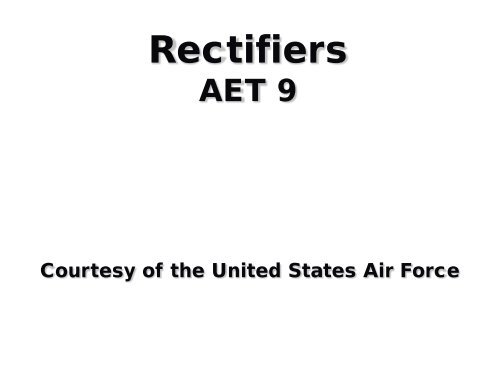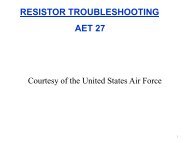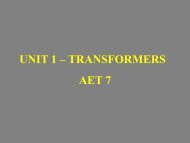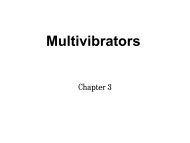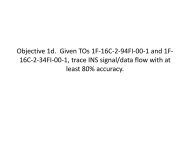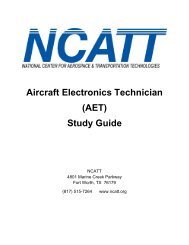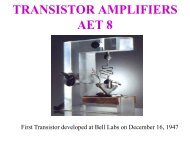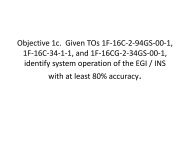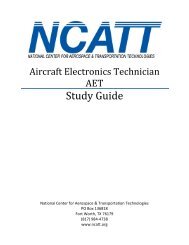ALTERNATING CURRENT - NCATT
ALTERNATING CURRENT - NCATT
ALTERNATING CURRENT - NCATT
You also want an ePaper? Increase the reach of your titles
YUMPU automatically turns print PDFs into web optimized ePapers that Google loves.
Unit 2 - Objective2a. Identify power supply rectifieroperating principlesOVERVIEW• 2. Characteristics– Half-wave Rectifier– Full-wave Rectifier– Full-wave Bridge Rectifier• 3. Operation– Half-wave Rectifier– Full-wave Rectifier– Full-wave Bridge Rectifier
Purpose• Before we get into rectifiers, we are goingto briefly discuss the entire power supplyACSOURCE TRANSFORMER RECTIFIER FILTERVOLTAGEREGULATORTOLOAD• The purpose of the powersupply is to convert AC voltageinto DC voltage, for use incircuits where AC voltage is notacceptable
Purpose• An AC sine wave is fed into thetransformerACSOURCE TRANSFORMER RECTIFIER FILTERVOLTAGEREGULATOR*• The purpose of the transformeris to step-up or step-down theAC voltage or currentTOLOAD
• It also determines the polarityof the output voltagePurpose• The transformed AC sine wave is fed intothe rectifierACSOURCE TRANSFORMER RECTIFIER FILTERVOLTAGEREGULATORTOLOAD*• The purpose of the rectifier is tochange the AC into pulsating DC
Purpose• The pulsating DC is fed into the filterACSOURCE TRANSFORMER RECTIFIER FILTERVOLTAGEREGULATOR*• The purpose of the filter is tochange the pulsating DC into asmooth DCTOLOAD
Purpose• The Smooth DC is fed into the voltageregulatorACSOURCE TRANSFORMER RECTIFIER FILTERVOLTAGEREGULATOR*• The purpose of the voltageregulator is to keep the outputDC voltage constant underchanging input AC voltage orload conditionsTOLOAD
Rectifier Operating Principles• Load• Term used to describe the actual device thatdraws current from the power supply• The load represents all of the circuits servedby the power supply• A large load means high current, and a lowcircuit resistance
Sine Wave Terms• Sine wave• Peak voltage• Peak-to peakvoltage• Effectivevoltage• Alternation• Formulas0VEFFECTIVE VOLTAGE = PEAK VOLTAGE X .707PEAK VOLTAGE EFFECTIVE X 1.414POSITIVEPEAKVOLTAGENEGATIVEPEAKVOLTAGEPOSITIVEALTERNATIONCYCLENEGATIVEALTERNATION
Sine Wave Terms• Sine Wave - A voltage or current that iscontinually changing in amplitude, andperiodically changes polarity• Peak Voltage - The maximum amplitude ofthe wave on either the positive or negativealternation• Peak-to-Peak Voltage - The swing involtage from the maximum negative peak tothe maximum positive peak
Sine Wave Terms• Effective Voltage (RMS) - Theamount of alternating current or voltagethat produces the same heating effect anequal amount of direct current or voltage• Alternation - The variation, eitherpositive or negative, of a waveform fromthe reference (often zero volts) tomaximum and back to the reference
Sine Wave Terms• Formulas• Epk = ½ x Epk-pk• Epk = 1.414 x Erms• Epk-pk = 2 x Epk• Epk-pk = 2.828 x Eeff• Eeff = .707 x Epk• Eeff = .3535 x Epk-pk
Characteristics• The next circuits we discuss will include thefirst two parts of our power supply, thetransformer and the rectifier• We will cover three different types of rectifiers:–Half-wave–Full-wave–Full-wave Bridge
Characteristics• Half-wave - This circuit consists of one diode, whichwill be biased by the secondary of the transformer.There is a resistor (R L ) in series with the diode, and isused to develop the output voltage• Full-wave - This circuit consists of two diodes, biasedby a transformer with a center-tapped secondary.There is a resistor (R L ) in series with the diodes, and isused to develop the output voltage• Full-wave Bridge - This circuit consists of four diodes,biased by the secondary of the transformer. Thelayout is normally shown in a diamond shapedarrangement. There is a resistor (R L ) in series withthe diodes, and is used to develop the output voltage
Operation - Half-Wave Rectifier• We apply the AC to the transformer• If a high voltage is required, a step-up transformer isused; if a low voltage is required, a step-downtransformer is used• If we do not need a change in voltage level, a one-toone(1:1) transformer is usedAC INPUTT11:1 CR1+++ OUTPUTVOLTAGERL–––0V
Operation - Half-Wave Rectifier• The transformer also helps to isolate the DCoutput from the AC input• The phasing dots on this transformer signifythat the voltage polarities at these points arethe sameAC INPUTT11:1 CR1+++ OUTPUTVOLTAGERL–––0V
Operation - Half-Wave Rectifier• When a diode is forward biased, its resistancedecreases, and majority current flows• When a diode is reverse biased, its resistanceis very large, and we have no majority currentflowAC INPUTT11:1 CR1+++ OUTPUTVOLTAGERL–––0V
Operation - Half-Wave Rectifier• A diode placed in series with an AC source and a loadresistor (R L ) will have both forward and reverse biasapplied with every cycle• A forward biased diode allows current to flow, so wehave a pulse of DC in the output• R L represents all of the circuits that will draw currentfrom the rectifierAC INPUTT11:1 CR1+++ OUTPUTVOLTAGERL–––0V
Operation - Half-Wave Rectifier• We will start with the positive alternation• The voltage at the top of T1’s primary is positive• The voltage on the top of the secondary is alsopositive (because of the phase dots)• The secondary is functioning as the power source forthe rectifier and the load circuitsAC INPUTT11:1 CR1+++ OUTPUTVOLTAGERL–––0V
Operation - Half-Wave Rectifier• The positive voltage felt on the anode of CR1 willforward bias it• Majority current flows AGAINST the arrow• Current will flow from the bottom of the secondary,through R L , through the diode, and back to the top ofthe secondary• Since R L is very large, it will drop (develop) nearly allthe secondary voltage across R L , and it represents thepositive half of the AC input voltage• We disregard the voltage drop across the forwardbiased CR1
Operation - Half-Wave Rectifier• When the input goes through the negative alternation,the voltage at the top of T1’s secondary is negative• This puts a negative potential on the anode of CR1,reverse biasing it• The diode’s resistance is so large that majority currentstopsAC INPUT–T11:1 CR1–RLOUTPUTVOLTAGE++0V
Operation - Half-Wave Rectifier• Even though minority current could flow, we consider itto be negligible, and say that the output is zero• This circuit is called a half-wave rectifier because itonly allows majority current to flow for half of the inputAC waveform• This circuit produces a positive output• If a negative output is required, we can reverse thediode, allowing current to flow in the opposite direction• The next slide compares the positive output rectifier toone with a with a negative polarity output
Operation - Half-Wave Rectifier• In the first diagram, the positive alternation forward biases thediode, while in the second diagram the negative alternationforward biases the diodeAC INPUTT11:1 CR1+++ OUTPUTVOLTAGERL–––0VAC INPUTT1A 1:1RECTIFIERCR1– – – OUTPUTRL+ + +0VVOLTAGE
Operation - Half-Wave Rectifier• The direction of the diode determines the polarity of the output,not the phasing of the transformer• As proof, our next slide will compare two circuits, with differenttransformer phasingAC INPUTAC INPUT+–T11:1 CR1+–T11:1 CR1+ OUTPUTVOLTAGERL–RL0V– – – OUTPUT+ + +0VVOLTAGE
Operation - Half-Wave Rectifier• During the positive alternation, the transformer in the first circuitpasses a positive to the anode (forward biasing it), while in thesecond circuit, the transformer puts a negative potential on theanode (because of the phase difference)OWAC INPUTV1:20VOUTPUTVOLTAGEOUTPUT
Operation - Half-Wave Rectifier• During the negative alternation, the transformer in thefirst circuit will pass a negative to the anode (reversebiasing it), while in the second circuit, the transformerwill put a positive potential on the anode (forwardbiasing it)• The diode was facing in the same direction in both ofthese circuits, but because of the phase differencethey receive different alternations• Transformer phase has no effect on output polarity
Operation - Half-Wave Rectifier• Now that we’ve seen how current flows andhow we develop an output in the half waverectifier, let’s apply an AC voltage of definitevalues• These same values and formulas will work nomatter if we’re using a positive output ornegative output rectifier
Operation - Half-Wave Rectifier• In this diagram, we have a positive output half-waverectifier with an input voltage of 200VAC (200 Veff)• The secondary is also 200VAC, or 282.8 Vpk• The positive alternation passes, leaving a positivevoltage output pulse of 282.8 Vpk• We disregard the voltage drop across the diode in ourcalculationsAC INPUT60 Hz200 VACCR1200 VAC (EFF)OR 282V PEAKRL+282V0V–282VAC INPUTPEAKVOLTAGE = +282VAVERAGEVOLTAGE = +90V0V
Operation - Half-Wave Rectifier• We can measure the voltage peak across R L using anoscilloscope• However, if we were to use a voltmeter, we would readthe average voltage• The average voltage of an unfiltered half-wave rectifieris .318 x Peak output voltage• Therefore, a DC voltmeter would read about +90VDC(.318 x +282.8 Vpk = +89.93VDC)AC INPUT60 Hz200 VACCR1200 VAC (EFF)OR 282V PEAKRL+282V0V–282VAC INPUTPEAKVOLTAGE = +282VAVERAGEVOLTAGE = +90V0V
Operation - Half-Wave Rectifier• The output voltage of the half-wave rectifier is in theform of pulses• In a half-wave rectifier, we get one pulse of outputvoltage for every cycle of input AC; this means that thefrequency of the output is the same as the input• The output frequency of a rectifier is given in Pulsesper-Second(PPS); we call it the ripple frequency(here, the input frequency is 60Hz, and the ripplefrequency is 60PPS)AC INPUT60 Hz200 VACCR1200 VAC (EFF)OR 282V PEAKRL+282V0V–282VAC INPUTPEAKVOLTAGE = +282VAVERAGEVOLTAGE = +90V0V
Operation - Half-Wave Rectifier• Notice that the output voltage in this circuit goes fromzero to 282V and back to zero• We call this peak voltage change of 282V the rippleamplitude• The lower the ripple frequency, and the higher theripple amplitude, the more difficult it will be to changethis pulsating DC to a smooth DCAC INPUT60 Hz200 VACCR1200 VAC (EFF)OR 282V PEAKRL+282V0V–282VAC INPUTPEAKVOLTAGE = +282VAVERAGEVOLTAGE = +90V0V
Interim SummaryHalf-wave Rectifier• Has one diode• Direction of diode determines polarity of output voltage• Output peak voltage determined by turns ratio oftransformer• Output ripple frequency (in PPS) equals inputfrequency (in Hz)• Output ripple amplitude is the same as the transformersecondary voltage• Average DC output voltage equals .318 times the peak
Operation - Full-Wave Rectifier• We apply the AC to the transformer• The phase dots signify that the voltage polarities atthese points are the same• The most noticeable difference is the center tap on thesecondary of the transformerAC INPUTT11:1 CR1+ +OUTPUTVOLTAGE– –CR2RL
Operation - Full-Wave Rectifier• The center-tapped transformer divides the secondaryvoltage into two equal amplitude voltages that will beopposite in polarity with respect to the tap (ground)• The transformer’s center tap is also tied to one end ofR L providing a current path through the load resistorAC INPUTT11:1 CR1+ +OUTPUTVOLTAGE– –CR2RL
Operation - Full-Wave Rectifier• The circuit could be drawn like this, creatingtwo half-wave rectifiers, producing an outputpulse for each of the alternations• Both of the pulses will be the same polarityand amplitudeAC INPUTT11:1 CR1RLOUTPUTVOLTAGECR2
Operation - Full-Wave Rectifier• The positive voltage at the top of thesecondary (with respect to ground) will forwardbias CR1• The negative voltage at the bottom of thesecondary (with respect to ground) will reversebias CR2AC INPUTT11:1 CR1+ +OUTPUTVOLTAGE– –CR2RL
Operation - Full-Wave Rectifier• Ground is negative with respect to the top of thesecondary, so current flows from ground, up throughR L , through CR1 (against the arrow), and back to thetop of T1• Since CR2 is reverse biased, it is “shut off” during thisalternationAC INPUTT11:1 CR1+ +OUTPUTVOLTAGE– –CR2RL
Operation - Full-Wave Rectifier• This develops an output voltage across R L that ispositive with respect to ground• The peak amplitude of the output is ½ the peaksecondary voltage because the secondary is centertapped• We ignore the voltage drop across CR1AC INPUTT11:1 CR1+ +OUTPUTVOLTAGE– –CR2RL
Operation - Full-Wave Rectifier• The negative alternation causes a negative voltage atthe top of the secondary (with respect to ground) willreverse bias CR1• The positive voltage at the bottom of the secondary(with respect to ground) will forward bias CR2T11:1 CR1– –200 VAC60 Hz+ +CR2RL
Operation - Full-Wave Rectifier• Ground is negative with respect to the bottom of thesecondary, so current flows from ground, through R L ,through CR2 (against the arrow), and back to thebottom of T1• CR1 is reverse biased, so it is “shut off”T11:1 CR1– –200 VAC60 Hz+ +CR2RL
Operation - Full-Wave Rectifier• The current flows through R L in the same direction forboth alternations of the input• This produces two pulses of the same polarity andamplitude• Reversing both diodes will reverse the polarity of theoutput pulsesT11:1 CR1– –200 VAC60 Hz+ +CR2RL
Operation - Full-Wave Rectifier• Since we produce two pulses for every cycle,the ripple frequency is two times the AC inputfrequency (output in PPS equals 2 x inputfrequency in Hz)• Also, since we have two pulses per cycle, we’llcompute the average voltage differently (theformula will be .636 x Peak)• Remember, the peak is only ½ of the fullsecondary
Operation - Full-Wave Rectifier• If we use our earlier example of a 200VAC (282.8 Vpk)input, and a 1:1 transformer, we get a voltage acrossthe full secondary of 282.8 Vpk• The center tap puts ½ of this voltage available foreach diode (141.4 Vpk)T11:1 CR1– –200 VAC60 Hz+ +CR2RL
Operation - Full-Wave Rectifier• We now use our formula (.636 x Epk) to getthe resulting average voltage:.636 x 141.4 Vpk = 89.93 VDCT11:1 CR1– –200 VAC60 Hz+ +CR2RL
Operation - Full-Wave Rectifier• You can see that both the half wave andfull wave rectifiers can have the sameAverage voltage (as long as the inputamplitude and transformer turns ratio isthe same)• When compared to a half wave rectifier,we find that the full-wave has a higherripple frequency• This allows us to easily filter the output ofa full-wave rectifier
Operation - Full-Wave Rectifier• The ripple amplitude of the unfiltered fullwaverectifier may be smaller than that ofthe half-wave, only because the peakoutput of the full-wave rectifier is half thepeak of the secondary• In order for the half-wave and the fullwaverectifiers to have the same peakoutputs, the transformer of the full-wavemust have double the turns ratio of thehalf wave
Full-Wave Bridge Rectifier• The bridge rectifier is a type of full waverectifier• It differs from the previous full-wave rectifier inthat a center-tapped transformer is not used,and it requires four diodes1:1CR1200 VAC60 Hz282 VPEAKCR4CR3CR2R L
Full-Wave Bridge Rectifier• This rectifier, like the previous full-wave,allows both the positive and negativealternations of the sine wave to be used• Our next slides will show how this is possible1:1CR1200 VAC60 Hz282 VPEAKCR4CR3CR2R L
Full-Wave Bridge Rectifier• The positive alternation forward biases CR3 and CR4• CR2 is reverse biased (has a negative voltage appliedto its anode)• CR1 is reverse biased (has a positive voltage appliedto its cathode1:1+ +CR1200 VAC60 Hz282 VPEAKCR4CR3+CR2– – –RL+282V0V– 282VACINPUT+282V0VOUTPUTVOLTAGEAQR30020010-9307-1380
Full-Wave Bridge Rectifier• Current flows from the transformer, through CR4 to theground• The ground is attached to one end of R L , so currentflows up through R L• From the top of R L , current flows through CR3 back tothe transformer1:1+ +CR1200 VAC60 Hz282 VPEAKCR4CR3+CR2– – –RL+282V0V– 282VACINPUT+282V0VOUTPUTVOLTAGEAQR30020010-9307-1380
Full-Wave Bridge Rectifier• Current flows through the diodes against thearrows• You see that the voltage at the top of R L ispositive with respect to ground1:1+ +CR1200 VAC60 Hz282 VPEAKCR4CR3+CR2– – –RL+282V0V– 282VACINPUT+282V0VOUTPUTVOLTAGEAQR30020010-9307-1380
Full-Wave Bridge Rectifier• The negative alternation forward biases CR1and CR2• CR3 and CR4 are reverse biased1:1– –200 VAC60 Hz282 VPEAKCR1CR3+OUTPUTVOLTAGE+ +CR4CR2–R L+282V0V– 282VACINPUT+282V0VOUTPUTVOLTAGEAQR30020010-9307-1380
Full-Wave Bridge Rectifier• Current flows from the transformer, throughCR1 to the ground• Current flows up through R L• From the top of R L , current flows through CR2back to the transformer1:1– –200 VAC60 Hz282 VPEAKCR1CR3+OUTPUTVOLTAGE+ +CR4CR2–R L+282V0V– 282VACINPUT+282V0VOUTPUTVOLTAGEAQR30020010-9307-1380
Full-Wave Bridge Rectifier• You see that the voltage at the top of R L is positivewith respect to ground• The direction of the diodes determines the polarity ofthe output voltage (direction of current through R L1:1– –200 VAC60 Hz282 VPEAKCR1CR3+OUTPUTVOLTAGE+ +CR4CR2–R L+282V0V– 282VACINPUT+282V0VOUTPUTVOLTAGEAQR30020010-9307-1380
Full-Wave Bridge Rectifier• The Bridge rectifier produces two outputpulses for each input cycle (output freq in PPS= 2 x input freq in Hz)1:1– –200 VAC60 Hz282 VPEAKCR1CR3+OUTPUTVOLTAGE+ +CR4CR2–R L+282V0V– 282VACINPUT+282V0VOUTPUTVOLTAGEAQR30020010-9307-1380
Full-Wave Bridge Rectifier• Since both alternations produce a pulse, andthe voltage of the entire secondary is used,then the average voltage equals .636 x peakof the secondary1:1– –200 VAC60 Hz282 VPEAKCR1CR3+OUTPUTVOLTAGE+ +CR4CR2–R L+282V0V– 282VACINPUT+282V0VOUTPUTVOLTAGEAQR30020010-9307-1380
Full-Wave Bridge Rectifier• The unfiltered bridge rectifier has a higheraverage voltage that either the half or full waverectifiers1:1– –200 VAC60 Hz282 VPEAKCR1CR3+OUTPUTVOLTAGE+ +CR4CR2–R L+282V0V– 282VACINPUT+282V0VOUTPUTVOLTAGEAQR30020010-9307-1380
Full-Wave Bridge Rectifier• The ripple frequency is higher than that of ahalf wave, which makes it easier to change thepulsating DC to smooth DC1:1– –200 VAC60 Hz282 VPEAKCR1CR3+OUTPUTVOLTAGE+ +CR4CR2–R L+282V0V– 282VACINPUT+282V0VOUTPUTVOLTAGEAQR30020010-9307-1380
Full-Wave Bridge Rectifier• The ripple amplitude of the bridge rectifier willbe the same as that of the half wave1:1– –200 VAC60 Hz282 VPEAKCR1CR3+OUTPUTVOLTAGE+ +CR4CR2–R L+282V0V– 282VACINPUT+282V0VOUTPUTVOLTAGEAQR30020010-9307-1380
Rectifier Summary
Unit 2 - Objective2a. Identify power supply rectifieroperating principles• 1. Purpose– Power Supply• Transformer• Rectifier• Filter• Voltage Regulator– AC Terms
Unit 2 - Objective2a. Identify power supply rectifieroperating principles• 2. Characteristics– Half-wave Rectifier– Full-wave Rectifier– Full-wave Bridge Rectifier• 3. Operation– Half-wave Rectifier– Full-wave Rectifier– Full-wave Bridge Rectifier


